
ABCD is square having its centre ai the origin. If A is(x,y), find the remaining vertices.
By a suitable translation of axes or otherwise, find the vertices of the square two of whose opposite vertices are(4,5) and (-2,-3).
-
UP 0 DOWN 0 0 4

4 Answers
aieee are you sure you have done a square and not a rectangle..
from there what could be done is find the slope of first diagonal..
then the slope of the second .. then try..
If A is (h,k) and centre is at origin then C = (-h,-k). Slope of diagonal AC = k/h
So slope of BD = -h/k
As BD passes thru origin, eqn of BD is y= (-k/h)x
i.e. hy + kx =0 .. (a)
length of diagonal = 2(h2+k2)1/2 => length of side = (2h2+2k2)1/2
Let B and D be (h1,k1) and (-h1,-k1)
Then h2+k2 = h12+k12 .. (i)
further, (h1-h)2 + (k1-k)2 = 2h2+2k2
=> hh1 + kk1 =0
BUT hk1 + kh1 = 0 (from (a))
=> h(h1-k1) = k(h1-k1)
=> h=k or h1=k1
So the other two vertices are (h1,h1) and (-h1,-h1)
But as h2+k2 = 2h12
=> h1 = (h2+k2)1/2